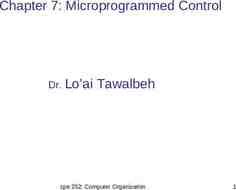Child Care Regulation Updates New School Readiness Requirements
50 Slides3.14 MB
Child Care Regulation Updates New School Readiness Requirements
CCDF Reauthorization What is it? Child Care and Development Block Grant (CCDBG) Act of 2014 signed into law 11/19/14 Reauthorizes Child Care and Development Fund (CCDF) program for first time since 1996 CCDF is 5.3B block grant that gives funds to states to provide access to child care services; in Florida School Readiness Program Source: ACF Office of Child Care 2
New School Readiness Requirements Health and Safety Monitoring (School Readiness Providers) – Annually conducted by licensing staff Training Requirements (School Readiness Providers) – Timeframes for completion of training (Pre-Service) – Annual in-service training Group Size and Staff-to-Child Ratio (School Readiness Providers) – Establish Group Size and Staff to Child Ratio Background Screening (All Providers) – New components used to determine qualification
Provider Types Impacted Contracted to Participate in School Readiness with local ELC: Licensed Child Care Facilities Licensed Family Day Care Homes Large Family Child Care Homes Registered Family Day Care Homes Religious-Exempt Child Care Facilities Non-Public Schools Public Schools Informal Child Care Providers Other exempt/non-licensed provider types 4
Health and Safety Monitoring Any provider who accepts school readiness funds must allow the department or local licensing authority to perform inspections to verify compliance with health and safety standards established by Office of Early Learning (OEL.) This applies to licensed and license-exempt providers. 5
The Inspection Specific School Readiness templates have been issued for license exempt providers Inspected Annually. Licensed Providers have additional standards added to current templates - Inspected Annually; Group Size, Training, Expulsion, and Emergency Prep Policies. Health and Safety standards have been adopted by OEL in rule. 6
Technical Assistance New School Readiness standards that were adopted in rule 6M-4.620, F.A.C. became effective on October 24, 2016. Technical Assistance will be given on first visit. 7
Technical Assistance To access the new health and safety requirements visit the following link: https://www.flrules.org/gateway/RuleNo.asp?title Office%20of%20Early %20Learning%20-%20School%20Readiness%20Program&ID 6M-4.620 8
Technical Assistance Current providers whose School Readiness contract was signed on or before December 31, 2016 must achieve compliance with the standards according to the following sequential deadlines: 9
Technical Assistance March 31, 2017 Pre-service training Requirements. -June 30, 2017 All other health and safety standards. -October 25, 2018 Active Credential Requirement related to group size. 10
Pre-service Training Pre-Service Training - Training must be completed within 90 days of the date of hire, with a program participating in the School Readiness program. 11
Pre-service Training Training must be documented on the Department’s training transcript Or the ‘Early Learning Florida’ transcript. 12
Pre-Service Training This is referred to as pre-service training and personnel who have not completed all preservice training requirements may not be allowed any unsupervised contact with, or care of children in a school readiness program Due March 31, 2017. 13
Pre-service Training This is referred to as pre-service training, and personnel in a LFCCH who have not completed all pre-service training requirements may not be allowed any unsupervised contact with or care of children in a school readiness program Due March 31, 2017. 14
Group Sizes/Ratios Establishes a maximum number of children that can be in one classroom area. Group size does not apply during times of outdoor play, provided that ratios and the applicable square footage requirements are maintained at all times. 15
Group Size Prior to making changes to classroom set-up by adding stable walls/barriers to divide classroom space you are encouraged to reach out to your local fire department for guidance and assistance Due June 30, 2017. You must also have your Licensing Counselor come to re-measure the facility when changes are needed. 16
Group Size Birth -12 months not to exceed 12 children 1 y -24 months not to exceed 12 children 2 y – 3 y not to exceed 22 children 3 y – 4 y not to exceed 30 children 4 y – 6 y not to exceed 40 children 17
Group Size In groups of mixed age ranges, where children one year of age but under two years of age are included, the group size for the youngest population present applies. In groups of mixed age ranges, where children two years of age or older are included, the group size for the majority population present applies. 18
Group Size Important! As the group size increases and requires additional staff to meet ratio, one staff must possess at a minimum an active credential. Due October 25, 2018. 19
Group Size For FDCH and LFCCH Group Size for FDCH and LFCCH – Establishes a maximum number of children that can be in one classroom area and is the same as the ratio categories required for licensing. Due June 30, 2017. 20
Group Size For FDCH A maximum of four children from birth to 12 months of age. A maximum of three children from birth to 12 months of age, and other children, for a maximum total of six children. A maximum of six preschool children if all are older than 12 months of age. A maximum of 10 children if no more than 5 are preschool age and, of those 5, no more than 2 are under 12 months of age. 21
Group Size For LFCCH A maximum of 8 children from birth to 24 months of age. A maximum of 12 children, with no more than 4 children under 24 months of age. 22
Expulsion Policy Expulsion Policy - Each school readiness program must have written policies and procedures regarding discipline and expulsion of children in care. 23
Expulsion Policy A copy of the current policies must be available to the inspection authority to review. 24
Expulsion Policy Verification that the program has provided the parent or guardian a written copy of the disciplinary and expulsion policies used by the program must be documented in the child’s file with the signature of the custodial parent or legal guardian Due June 30, 2017. 25
Emergency Preparedness Emergency Preparedness - The plan must facilitate parent/guardian reunification onsite and offsite. 26
Emergency Preparedness The plan must include accommodations for infants and toddlers, if applicable. The plan must describe how the facility will meet the needs of all children, including children with special needs or with chronic medical conditions, during and following an emergency event Due June 30, 2017. 27
Sharing Of The Inspection The results of this inspection will be shared with the ELC as a component of the program’s School Readiness contract file. If you have additional questions concerning the new rule changes you may contact your licensing counselor or local licensing office. 28
BACKGROUND SCREENING CHANGES 29
Criminal background checks Requires state to conduct criminal background checks on all child care providers and their staff members. Includes child care staff members who don’t care directly for children but have access to children. Conducted at least every five years. Includes state criminal and sex offender registry and state child abuse and neglect registry in any state where staff member has resided over past five years. 30
Background Screenings Employment history checks must be completed for preceding 5 years. Search of criminal history records, sexual predator and sexual offender registry, and child abuse and neglect registry for any state in which the applicant resided in the past 5 years All background screening for child care must go through the Clearinghouse. – This includes child care personnel working in programs within public and non-public schools, including before/after school programs 31
Background Screenings All child care personnel must be rescreened under the new law requirements by May 31, 2017: – Child Care Program Office and the Background Screening unit created a public awareness campaign on the new law changes – From September 2016- May 2017, child care providers are to begin rescreening personnel hired prior to July 1, 2016 – Technical Assistance will be provided during each inspection during that time period – Beginning June 2017, the Department will begin monitoring/enforcement for compliance 32
Background Screening Clearinghouse The Clearinghouse is a one-stop shop for screening. Advantages to using the clearinghouse include: – Ability to share results of criminal history checks among the specified agencies. – Ability for current employers of the individual to view subsequent arrest information for employees with retained fingerprints. – Ability to track screenings from the time the screening request is initiated in the Clearinghouse until a determination is made. – Provides email notification to the user regarding status updates to requests initiated. 33
Background Screening Clearinghouse Get Access! Providers need to establish a Clearinghouse account in order to: – Initiate screenings/set up appointments – View screening results – Maintain employee roster (add/remove employees) – Receive important alerts – Cost Savings 34
Background Screening Clearinghouse Clearinghouse Home Screen 35
Background Screening Clearinghouse Provider Process Steps: Complete Search in the Clearinghouse prior to sending staff to live scan provider If the individual is not found after a search, there is not prior screening in the Clearinghouse, select “Initiate Screening” 36
Background Screening Clearinghouse Search Screen 37
Background Screening Clearinghouse Initiate a New Screening July 1, 2016 all screening must be processed through the Clearinghouse Must use LIVESCAN vendor that is Clearinghouse compatible List all states where the individual has lived in the preceding 5 years Maintain employee roster (must be updated within 10 days of a change) Remove employee(s) from roster when employment ends 38
Background Screening Clearinghouse Appointment Request Form 39
Background Screening Clearinghouse Individual has a Profile If the individual has a profile already in the Clearinghouse, with a Clearinghouse screening available status (“Yes’) and a status of DCF Child Care Eligible, the individual does not have to go to a live scan vendor for fingerprinting again. Just add the individual to your employee roster. If the eligibility indicates an Agency Review is required select initiate agency review. If there has been a break in service of 90 days, select initiate resubmission. IMPORTANT: All Employees, Substitutes, volunteers, or household members must be immediately added to your roster 40
Background Screening Clearinghouse Person Profile 41
Background Screening Clearinghouse IMPORTANT NOTE: All fingerprinting must occur through a Clearinghouse Compatible vendor. Check the listing in the Clearinghouse prior to initiating and scheduling an appointment with a vendor. Fingerprinting from a vendor that is not Clearinghouse compatible cannot be processed by DCF for the purposes of a clearance for child care employment. 42
Background Screening New Elements The Department’s Responsibility: – Issue a determination of Eligible or Non Eligible for employment in Child Care based on federal and state criminal history records – Search the National Sex Offender Registry – Search Florida’s Child Abuse and Neglect Registry – Send a Letter to Employer advising of the search of Florida’s Child Abuse and Neglect Registry 43
Background Screening Child Abuse and Neglect Search 44
Background Screening Clearinghouse Screening Result 45
Background Screening New Elements Employer/Provider/Operator Responsibility: – Conduct an employment history check(s) for the last five years. Document attempts (dates, times, contact number or method) to contact each employer At least three attempts must be made to obtain the reference 46
Background Screening New Elements Employer/Provider/Operator Responsibility: – If the employee lived outside of Florida in the preceding five years: Request State Criminal History Records from other states where the individual resided in the preceding five years Must send a request to each state requesting a search of the state’s child abuse and neglect registry for records Must check the applicants name on the sexual offender/predator website, for each state lived in for the past five years. 47
Background Screening New Elements Background Screening- Maintain Documentation in Personnel file (on-site): – Clearinghouse Background Screening Results – Employment history checks and attempts for the five year period – Affidavit of Good Moral Character – Letter from the Department of the search of the Child Abuse and Neglect Registry search – Documentation of search request and findings of the following: » Out of State Child Abuse and Neglect Searches » Out of State Sexual Predator/Offender website Searches 48
MAKE A PLAN Employer/Provider/Operator : Make a Plan to rescreen all child care personnel hired prior to July 1st, 2016 under the background screening requirements/ elements Owners, operators, employees, substitutes, volunteers, and household members Deadline May 2017 State must certify compliance 49
Questions? Katerina Maroney Samantha Wass de Czege Supervisor, School Readiness Policy Office of Early Learning [email protected] 850-717-8550 Director, Office of Child Care Regulation Department of Children and Families [email protected] 850-717-4374 Molly Grant Background Screening and Child Care Training Information Center Project Manager, School Readiness Office of Early Learning [email protected] 850-717-8550 Help Desk 1-888-352-2842 www.dcf.state.fl.us/programs/backgrounds creening/ 50























































